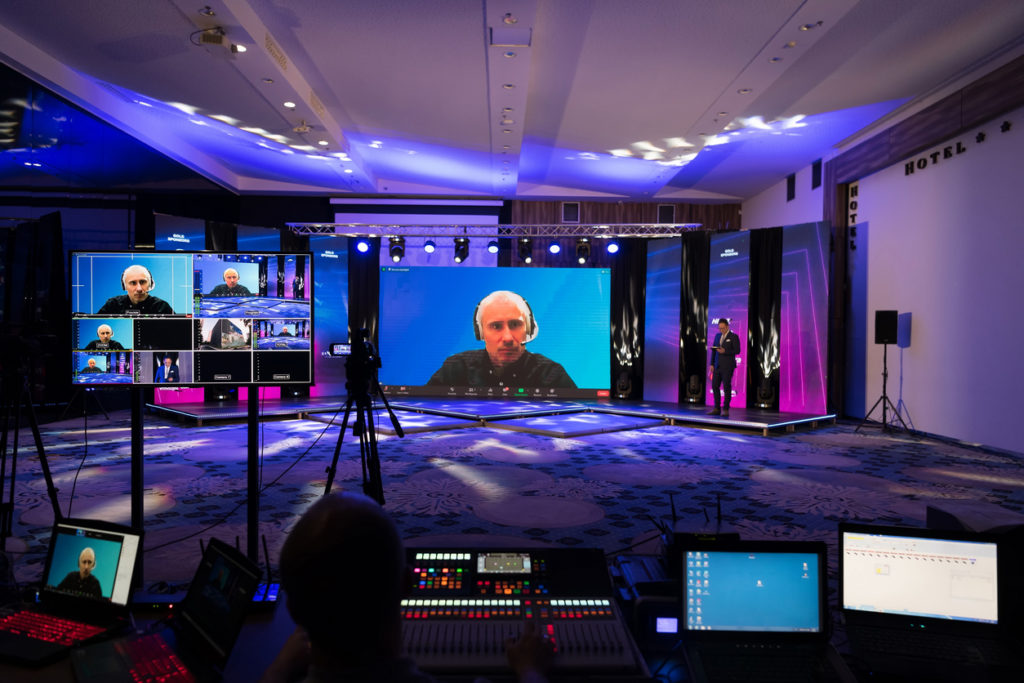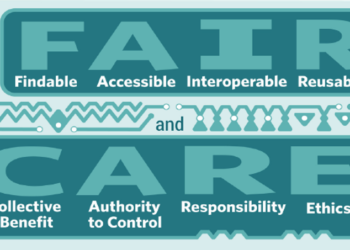Editor’s Note: Today’s post is by Danielle Cooper and Dylan Ruediger. Danielle is the Associate Director, Libraries, Scholarly Communication, and Museums, at Ithaka S+R, where she focuses on how information practices are evolving in higher education. Dylan is a senior analyst at Ithaka S+R, where he focuses on exploring research practices and communities. He is currently an SSP fellow.
The pivot to remote activities during the pandemic has led to a sharp increase in the recording of scholarly events hosted by universities and societies, including seminars and conferences. The surge in virtual meetings has in turn encouraged stakeholders in the scholarly communications sphere to question longstanding assumptions about the unique values of the in-person and digital modalities for events and outputs, and to imagine new opportunities for innovation at their intersection by leveraging video as a scholarly output. While video as a medium for scholarly outputs isn’t entirely new, momentum towards integrating video into the mainstream of scholarly communication has never been higher.
Even so, the question of how to achieve this integration is still very much an open one for scholars, publishers, societies, vendors, and universities. At Ithaka S+R, we’ve been exploring these questions through an ongoing collaboration with seventeen scholarly societies working to imagine the future of scholarly meetings, with generous funding from the Alfred P. Sloan Foundation. We’re also actively investigating the perspective of academic libraries as purchasers of streaming media, as part of a project in collaboration with twenty four universities interested in making streaming media more sustainable. In support of both these projects, we’ve interviewed executives of companies developing products to create a market for streaming video content from conferences, seminars, and other virtual or in-person meetings.
What we’ve learned so far is that the value of streaming video as a genre of scholarly communication — both as durable intellectual content and as a revenue source for individual academics, scholarly societies, conference organizers, publishers, and others — isn’t yet well established. Learning more about how and if researchers and teachers will make use of video presentations is one key unknown that makes understanding long-term economic demand for these materials difficult. Even so, a number of start-ups are building platforms and services around the assumption that these outputs can be monetized, though it is difficult to assess market share or profitability because the key players are not public. Our sense is that given the nature of the sector, it is possible all are in investment mode as they seek to develop a market. Our post today profiles four leading start-ups in this space to illustrate the promise — and pitfalls — that scholarly events hold for the academic streaming market and offer a taxonomy of this nascent market sector.

Defining the product
While providers tend to style themselves as tech companies, and — in most cases — focus on creating streaming platforms for scholarly video, several distinct strategic approaches leveraging video associated with events as a form of scholarly communications are emerging. Value propositions in the space focus on four overlapping but distinct areas of emphasis: 1. Providing solutions to societies, 2. Integrating conferences into scholarly communication workflows, 3. Building new networks, and 4. Recordings as content.
One approach is to develop boutique solutions for societies because they are the organizations that serve as the dominant unit for organizing the academic conferences and meetings that bring together scholars from across institutions. The start-up Cadmore Media is a notable actor in this space. Cadmore creates individualized platform-agnostic solutions to improve online engagement among scholars by ensuring that the events are dynamic and that the resulting streaming content is optimized for discovery. Cadmore’s offerings are perhaps the most individualized on the market, unusual in that they do not focus on providing a centralized platform but instead on improving the quality of video offerings and working with societies to develop financially sustainable models about how to best use their video content to support their missions.
LIke Cadmore, Morressier — the most established player in the sector — offers services designed to help societies strengthen and diversify their own product offerings across the scholarly communications lifecycle. Moressier’s core offering is a proprietary platform that integrates event hosting and the resulting video library into a larger publication workflow that integrates abstract management, peer review, and workflow tools with conference outputs including posters, presentation capture, proceedings, and journal articles. Like many companies (including those profiled in this piece), Morressier offers a platform for holding virtual conferences and hosting the resulting content, but their unique value proposition is their goal of creating a platform that will fully integrate conferences into the process of scholarly communication and publication.
A related approach focuses on using events and their resulting videos to build new networks among scholars. Cassyni, which is building its business by focusing on recordings produced by seminars rather than conferences, is perhaps the best example of this approach. Seminars are among the most ephemeral forms of scholarly gatherings, traditionally lacking the more centralized organizing logic of conferences that can ensure an impact that extends beyond those in the room. Cassyni provides a centralized platform optimized for seminar organizers, who are typically individuals or groups based at institutions, who have the benefit of their event recordings being made available, discoverable, and save-able for free to the scholarly community-at-large. Their tools are designed to allow users to replicate the intimacy of the seminar model by creating private seminars or facilitating community development through audience building tools.
A fourth approach is to develop solutions that focus on turning the recordings from scholarly meetings into a form of content that can be scaled and aggregated. This might be called the “Netflix approach.” The best example of this business model is Underline.io, which provides hosting services to societies but has as its strategic emphasis the desire to serve as a large-scale online aggregator of academic streaming content produced through conferences and other scholarly meetings. Underline.io’s goal is to partner with societies by licensing their event recording en masse and through a centralized platform to higher education institutions, particularly university libraries.
Integrating event video as a scholarly communications object
These new business strategies all raise the question of how conferences, seminars, and other scholarly events, and their resulting outputs, fit into the larger landscape of scholarly communications. An unresolved tension is how to balance the value of event recordings for later use with the opportunities that come from live engagement. The businesses we’ve profiled all take different positions on this issue: from making a choice to focus primarily on the afterlife of the outputs (Underline.io), to making entertainment and live engagement a core value (Cadmore), to trying to mediate between the two poles (Cassyni, Morressier).
Another important open question is how to situate recorded outputs from scholarly events in relation to other forms of scholarly communication, with the article still remarkably retaining the main gravitational pull as the version of record. All of the businesses profiled in this post want video to be taken seriously as an academic output. They all focus to a certain extent on making sure that video behaves like other established forms of scholarly communications, most notably by ensuring that there will be sufficient venues for discoverability by creating quality metadata, generating DOIs, or in the case of Cassyni, pursuing cross-product integration with a more established academic publisher (Elsevier). There is also a strong interest in how to maximize discoverability within the generated content, by developing new approaches to indexing within a recording or by improving transcription to ensure the highest quality textual record of the activities.
What is less clear is how these kinds of business interventions relate to efforts to make scholarly communications compatible with the open science movement. Should access to the content derived from scholarly events be a perk to institutions that can license it and/or members affiliated with organizations that produce it? A form of open standalone content or associated with an article serving as the version of record (that may or may not be publicly available)? An open alternative to other outputs stuck behind a paywall?
Final thoughts: Consolidation ahead
A final consideration is about the ultimate value of streaming event content to users and customers. Will researchers and teachers find significant value to this content? And to what extent will individual users or their institutions (likely through their libraries) be interested in purchasing this content or the platforms where they are hosted on these users behalf? Those who can develop viable offerings in this area have the potential to reshape the landscape of scholarly communications, and in the process diversify or build new revenue streams. But given the logistical complexities and unknowns about demand, much about the ways forward remain unclear.
If that value can be established, it is reasonable to expect consolidation and acquisitions within a sector currently dominated by start-ups. Beyond the Elsevier/Cassyni pilot, there is a conspicuous absence of other initiatives from established scholarly communication businesses, which may suggest that the opportunities presented by such start-ups at present are perceived to be so small or nascent as not to warrant much in the way of attention. It is also important that some are positioning themselves as explicitly eschewing a scaling approach, like Cadmore, or — in the case of Morressier — are already established enough to acquire rival start-ups. Even so, the well-established trend towards consolidation in the scholarly publishing industry suggests the likelihood that the largest companies in the business will become more active in this space.
Video recordings is just one format for leveraging events, and we are eager to see what more can be done with audio-only approaches that build on the general popularity of podcasting. And there are other video offerings, such as JOVE, which may or may not remain as standalone niche offerings against the consolidated diverse offerings provided through the largest vendors.
Discussion
2 Thoughts on "Guest Post — Event Streaming Start-Ups: A Strategic Overview and Taxonomy"
What would be interesting to me is whether academics actually want seminars recorded – is there a feeling in some disciplines that seminars act as a venue for early discussion and “feeling-out” of ideas which aren’t yet developed enough for publication, and that permanently recording seminars would inhibit scholars who would prefer them to stay ephemeral?
Echoing Mr. Eagle’s earlier comment about the value of a conference for testing out ideas, and having edited conference papers for old-school publications of proceedings, it is important to point out that there is often a “distance” between the conference paper and the published version, value added by formal post-delivery conference discussion and more casual conversations. This development is based on what is essentially a kind of informal peer review. Can this benefit be integrated into these packages?



